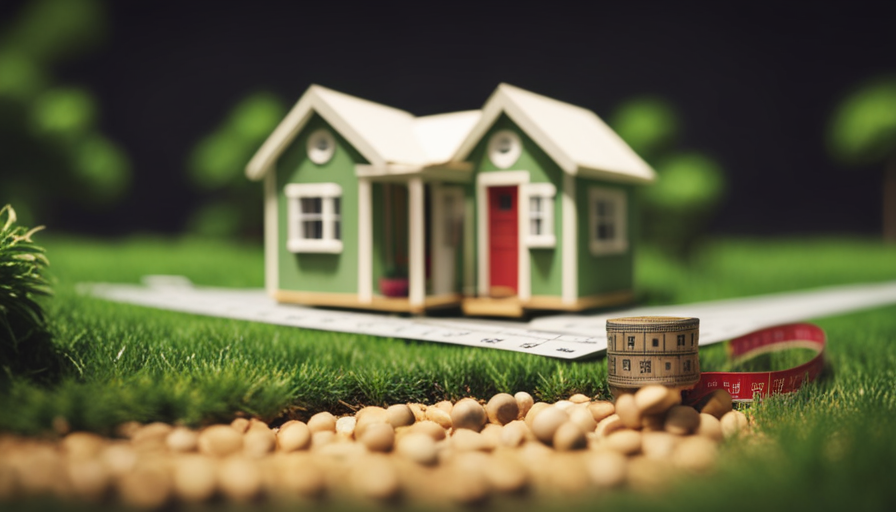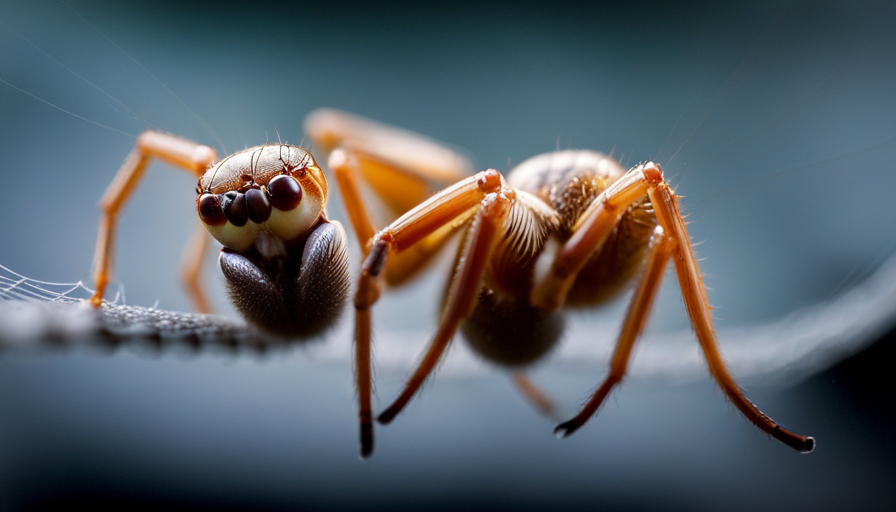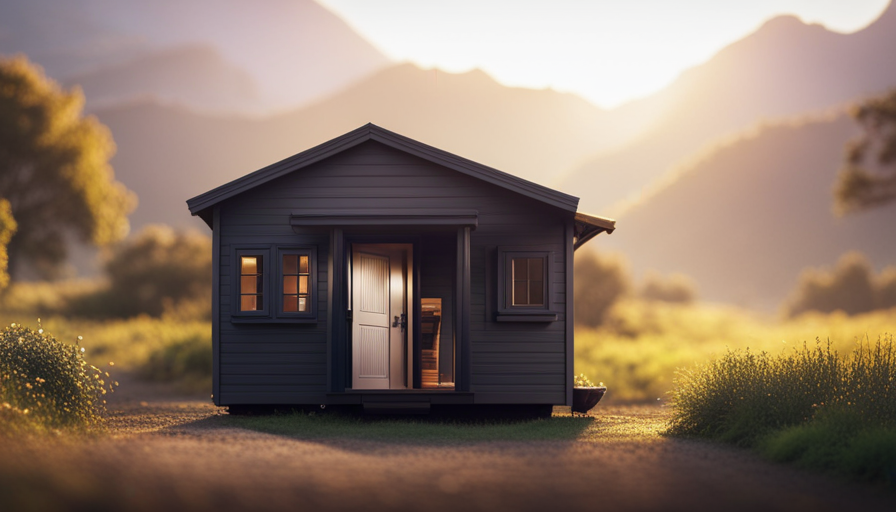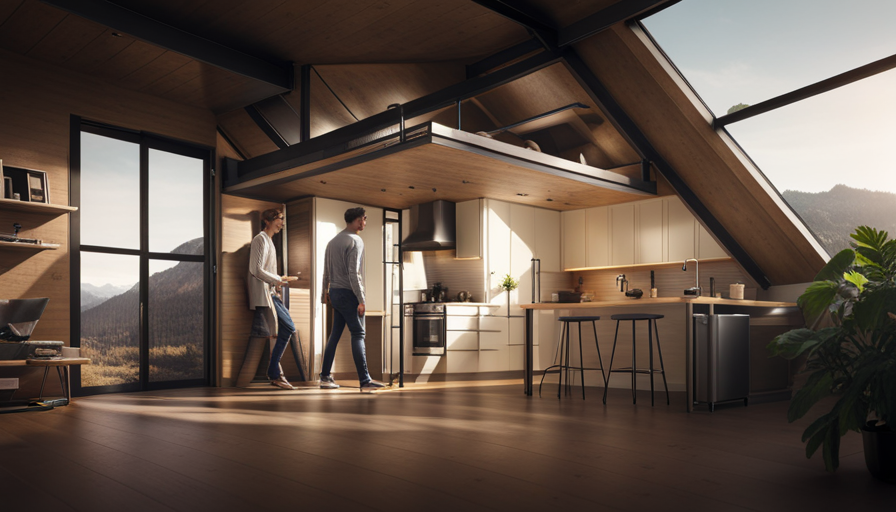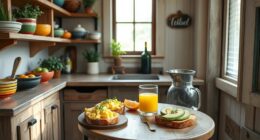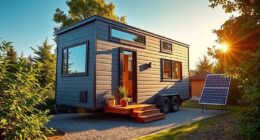Ever wondered what the largest size a tiny home can be? This question has captivated many enthusiasts and potential homeowners.
In this article, we will delve into the world of tiny houses and explore the possibilities of creating a spacious and comfortable living space within a compact footprint. Like a magician revealing their secrets, we will uncover the various design techniques and strategies employed by architects and builders to maximize space efficiency in tiny houses. From clever storage solutions to innovative furniture designs, we will uncover the secrets to achieving a sense of spaciousness in even the smallest of spaces.
But it’s not just about size; it’s about striking the perfect balance between comfort and functionality. We will discuss the key considerations when designing a large tiny house, from layout and flow to insulation and ventilation. By understanding these principles, you can create a home that not only feels spacious but also meets your everyday needs.
So join me as we embark on a journey into the world of tiny houses, where bigger is not always better, and where the possibilities for creating a truly remarkable living space are endless.
Key Takeaways
- Tiny houses are designed to maximize space and promote minimalist living, typically ranging from less than 500 square feet.
- Customization is key, with the use of alternative materials like reclaimed wood and shipping containers.
- Storage solutions are crucial in tiny houses, and creative options can be implemented both indoors and outdoors.
- Design factors to consider include energy efficiency, off-grid options, plumbing and waste management, and structural integrity.
Understanding the Concept of Tiny Houses
Did you know that tiny houses are all about maximizing space and living more simply? The tiny house movement has gained popularity in recent years as people embrace minimalist living and seek a more sustainable lifestyle.
Tiny houses are typically less than 500 square feet and are designed to make the most of every inch of space. These homes often feature multi-functional furniture, such as loft beds with storage underneath or dining tables that can be folded away when not in use.
The concept of tiny houses goes beyond just the physical size of the home. It is a mindset and a way of life that encourages people to prioritize experiences and relationships over material possessions. Living in a tiny house requires downsizing and decluttering, which can be a liberating experience for many.
Exploring different tiny house designs allows individuals to customize their living space to suit their needs and preferences. From sleek modern designs to rustic cabins, there are endless possibilities for creating a tiny home that reflects your personal style. Whether you choose to build your own tiny house or purchase a pre-made one, the key is to make the most of the limited space available.
In the next section, we will delve into the various factors to consider when designing a tiny house, including layout, storage solutions, and creative design ideas.
Exploring Different Tiny House Designs
Explore various designs for your compact dwelling and let your imagination soar as you envision the limitless possibilities of a pint-sized abode. When it comes to tiny house designs, there are countless options to consider.
One exciting aspect is exploring alternative materials that can be used, such as reclaimed wood, shipping containers, or even repurposed vehicles. These materials not only add a unique touch to your tiny house but also contribute to a more sustainable lifestyle.
In addition to materials, innovative storage solutions are a key consideration in tiny house design. With limited space, maximizing storage is crucial. Cleverly designed built-in cabinets, multipurpose furniture, and hidden storage compartments can help keep your tiny house organized and clutter-free. From loft beds with built-in drawers to stairs that double as shelves, there are endless ways to optimize every inch of your compact living space.
As we delve into the topic of legal and zoning considerations for tiny houses, it’s important to note that each locality has its own regulations. These regulations dictate where and how you can build your tiny house. Understanding these legal considerations is essential to ensure a smooth and hassle-free experience in bringing your dream tiny house to life.
Legal and Zoning Considerations for Tiny Houses
Navigating the legal and zoning considerations for compact dwellings can be a complex but crucial step in bringing your dream pint-sized abode to life. When it comes to legal considerations, it’s important to research and understand the laws and regulations surrounding tiny houses in your specific location.
Some areas may have minimum size requirements or restrictions on where you can park or build a tiny house. It’s essential to consult with local government agencies or a legal professional to ensure compliance with all applicable laws.
Zoning regulations also play a significant role in the feasibility of your tiny house project. Different zones may have specific rules regarding the use and placement of dwellings, which can impact the size, design, and location of your tiny house. Understanding the zoning regulations in your desired area is crucial to avoid potential issues or conflicts with local authorities.
To further engage the audience, I’ve created a nested bullet point list:
-
Key Legal Considerations:
- Minimum size requirements
- Parking and building restrictions
-
Zoning Regulations:
- Specific rules for dwellings in different zones
- Impact on size, design, and location of tiny houses
By familiarizing yourself with the legal considerations and zoning regulations, you can ensure that your tiny house project is compliant and avoid any potential setbacks. Maximizing space efficiency in tiny houses is the next crucial aspect to consider when designing your dream compact dwelling.
Maximizing Space Efficiency in Tiny Houses
To create a highly functional and efficient living space within your compact dwelling, optimizing every square inch becomes crucial – and did you know that the average tiny house utilizes innovative space-saving techniques to maximize usable area, achieving a stunning 64% more efficiency than traditional homes?
Maximizing storage is a key aspect of maximizing space efficiency in tiny houses. By utilizing vertical space with tall shelving units and hanging storage solutions, you can make the most of every inch. Additionally, incorporating multi-purpose furniture is a game changer. Beds that fold into walls or transform into seating during the day, tables that can be extended or collapsed as needed, and storage ottomans that double as seating are just a few examples of how multi-purpose furniture can provide both functionality and space-saving benefits.
By strategically arranging furniture and using clever storage solutions, you can create a seamless flow and make your tiny house feel much larger than it actually is. Balancing comfort and functionality in tiny houses is the next step in creating a truly livable space.
Balancing Comfort and Functionality in Tiny Houses
Achieving a harmonious balance between comfort and functionality in your compact dwelling is essential for creating a truly livable space. In a tiny house, every square inch counts, so it’s crucial to make thoughtful choices that prioritize both comfort and functionality. Here are some key considerations:
-
Comfort vs. aesthetics: When designing a tiny house, it’s important to strike a balance between creating a visually appealing space and ensuring maximum comfort. Opt for furniture and decor that not only look good but also provide comfort and functionality.
-
Storage solutions: Storage is a major challenge in tiny houses. To maximize space, consider utilizing multi-functional furniture with built-in storage compartments. Installing shelves, hooks, and racks on walls can also help optimize storage space.
-
Efficient layout: Designing an efficient layout is essential for a comfortable tiny house. Consider traffic flow, placement of furniture, and the arrangement of different zones within the house to ensure functionality while maintaining a cozy atmosphere.
-
Natural light: Incorporating ample natural light into your tiny house can enhance both comfort and functionality. Use large windows, skylights, and light-colored walls to create an airy and spacious feel.
-
Climate control: Ensuring proper climate control is crucial for comfort in a tiny house. Consider insulation, ventilation, and heating/cooling systems to maintain a comfortable and livable environment.
When designing a tiny house, it’s important to carefully consider these factors to create a space that is both comfortable and functional. By striking the right balance, you can design a tiny house that meets your needs and enhances your quality of life.
In the next section, we will explore the factors to consider when designing a tiny house without compromising on comfort or functionality.
Factors to Consider When Designing a Tiny House
When designing a tiny house, it’s crucial to consider factors such as energy efficiency and off-grid options. Incorporating energy-efficient features, like solar panels and energy-efficient appliances, reduces reliance on the grid and decreases environmental impact.
Carefully planning the plumbing and waste management systems ensures proper sanitation and water conservation.
Lastly, prioritizing structural integrity and implementing safety measures, such as fire-resistant materials and secure foundations, is essential to ensure the safety and durability of the tiny house.
Energy Efficiency and Off-Grid Options
Building a tiny house with energy-efficient features and off-grid options allows homeowners to live sustainably while embracing the idea that less is more. Incorporating energy-efficient appliances and solar power options into the design can significantly reduce the overall energy consumption of a tiny house. By choosing appliances with high energy efficiency ratings, such as Energy Star certified models, homeowners can minimize their energy usage without sacrificing functionality.
Additionally, integrating solar power options, such as solar panels and battery storage systems, can provide a renewable and sustainable source of electricity, allowing the tiny house to operate off-grid. These energy-efficient and off-grid features not only reduce the environmental impact of the tiny house but also provide homeowners with the freedom and flexibility to live in remote locations or areas with limited access to conventional power sources.
Transitioning to the subsequent section about plumbing and waste management systems, it is important to consider sustainable solutions for water usage and waste disposal.
Plumbing and Waste Management Systems
To ensure a sustainable and eco-friendly lifestyle, it’s crucial to implement efficient plumbing and waste management systems in your tiny home.
When it comes to plumbing installation, space optimization is key. Utilizing compact and innovative fixtures, such as low-flow toilets and small-scale water heaters, can help maximize limited space while minimizing water usage.
Additionally, incorporating greywater recycling systems allows for the reuse of water from sinks and showers for irrigation purposes, reducing overall water consumption.
Waste disposal methods in tiny homes often involve composting toilets, which convert waste into nutrient-rich compost without the need for traditional plumbing systems. These systems are not only environmentally friendly but also eliminate the need for costly sewage hookups.
With efficient plumbing and waste management systems in place, you can now focus on ensuring the structural integrity and safety measures of your tiny home.
Structural Integrity and Safety Measures
For optimal safety and structural stability, it is essential to prioritize the implementation of proper safety measures and ensure the structural integrity of your compact dwelling. When designing a tiny house, it is crucial to adhere to safety regulations and consider the structural stability of the building. This involves using high-quality materials and employing sound engineering principles to ensure the house can withstand various environmental factors. To illustrate this point, let’s consider a comparison between a traditional house and a tiny house:
| Aspect | Traditional House | Tiny House |
|---|---|---|
| Foundation | Concrete slab | Trailer |
| Structural Support | Load-bearing walls and beams | Steel framing |
| Roofing | Traditional trusses | Lightweight materials |
| Insulation | Standard insulation | Compact, energy-efficient insulation |
By prioritizing structural stability and following safety regulations, we can create tiny houses that are safe, durable, and comfortable. Now, let’s explore examples of large tiny houses to see how these principles are put into practice.
Examples of Large Tiny Houses
When it comes to large tiny houses, there are a few key points to consider.
First, spacious loft designs allow for maximum utilization of vertical space, creating a more open and comfortable living area.
Second, extensions and add-ons can be used to expand the overall square footage of the tiny house, providing additional living space and storage options.
Finally, the creative use of outdoor space is essential in maximizing the overall functionality and aesthetic appeal of a large tiny house.
By incorporating these elements, one can design a tiny house that feels spacious and comfortable, despite its small footprint.
Spacious Loft Designs
Loft designs in tiny houses can create the illusion of a spacious retreat, like a cozy cabin nestled in the mountains. These designs maximize vertical space by incorporating elevated sleeping quarters, leaving more room for other activities.
Spacious loft designs often include features such as high ceilings, large windows, and open layouts to enhance the feeling of openness and airiness. Loft storage solutions are also a key component of these designs, with built-in shelving, hidden compartments, and creative use of wall space to maximize storage options.
By utilizing these innovative designs, tiny house owners can enjoy the luxury of a larger living space within a compact footprint.
As we move into the next section about extensions and add-ons, it’s important to consider how these loft designs can seamlessly integrate with additional features to further enhance the overall functionality and comfort of a tiny house.
Extensions and Add-Ons
Extensions and add-ons can greatly expand the functionality and comfort of a tiny house, allowing for the integration of additional features to enhance the overall living experience. When it comes to extensions, there are various options available to customize your tiny house according to your needs. Here are some notable ones:
-
Porches: Adding a porch can create an outdoor living space, perfect for relaxing or entertaining guests.
-
Sunrooms: A sunroom extension can bring in natural light and provide a cozy spot for enjoying the surroundings.
-
Loft extensions: Extending the loft area can create additional sleeping or storage space.
-
Bump-outs: These small extensions can be used to increase the square footage of specific rooms, such as the kitchen or bathroom.
By incorporating these extensions and add-ons, you can maximize the potential of your tiny house and create a personalized living space that suits your lifestyle.
Now, let’s explore the creative use of outdoor space.
Creative Use of Outdoor Space
To truly maximize the potential of your cozy abode, consider unleashing your creativity and transforming the outdoor space into a multifunctional oasis.
Outdoor landscaping plays a crucial role in expanding the living area of a tiny house. Utilize the available land wisely by incorporating features like a patio, deck, or rooftop garden. These additions not only provide extra space for relaxation and entertainment but also enhance the overall aesthetic appeal of your tiny house.
Additionally, creative storage solutions can be implemented outdoors to optimize the limited indoor space. Consider utilizing vertical wall-mounted shelves, hanging baskets, or hidden compartments cleverly integrated into the outdoor design.
By strategically utilizing the outdoor space, you can create a seamless blend between indoor and outdoor living.
Now, let’s explore budgeting and financing options for building a tiny house, ensuring your dream home becomes a reality.
Budgeting and Financing Options for Building a Tiny House
When it comes to budgeting and financing options for building your tiny house, you’ll be pleasantly surprised by the numerous choices available. Here are four key considerations to help you navigate the financial aspects of your project:
-
Budgeting options: Start by determining your overall budget for the tiny house construction. Consider factors such as materials, labor, permits, and any additional costs like utilities or landscaping. Create a detailed budget plan to keep track of expenses and ensure you stay within your financial limits.
-
Financing options: Explore different ways to finance your tiny house project. Options include personal savings, loans from family or friends, traditional bank loans, or specialized tiny house loans. Research the interest rates, repayment terms, and eligibility criteria for each option to find the best fit for your financial situation.
-
Cost-saving strategies: Look for ways to minimize expenses without compromising on quality. Consider using reclaimed or recycled materials, DIY construction techniques, or purchasing second-hand appliances and fixtures. These cost-saving strategies can help stretch your budget and make your dream of owning a tiny house more attainable.
-
Alternative funding sources: Think outside the box and explore alternative funding sources such as crowdfunding platforms, grants, or sponsorships. These options can provide additional financial support and help you offset some of the expenses associated with building your tiny house.
Budgeting and financing options play a crucial role in building a tiny house. By carefully considering these aspects, you can ensure that your project remains on track and within your financial means. Transitioning into the subsequent section about the pros and cons of living in a large tiny house, it’s important to weigh the benefits and drawbacks of scaling up your tiny house design.
Pros and Cons of Living in a Large Tiny House
Advantages and disadvantages arise when opting for a more spacious tiny house design, so it’s crucial to assess the pros and cons before making a decision. Expanding the possibilities of a tiny house by making it larger can offer numerous benefits.
One of the main advantages is the increased living space, allowing for more comfort and freedom of movement. With a larger tiny house, it becomes easier to incorporate essential amenities such as a full-sized kitchen, bathroom, or even a separate bedroom. Additionally, a larger tiny house provides more storage options, making it easier to keep belongings organized and accessible.
However, there are also drawbacks to consider when thinking about a larger tiny house. The cost of building and maintaining a larger structure may be higher, as more materials and labor are required. Furthermore, a larger tiny house may require a larger plot of land, limiting the potential for mobility and flexibility that is often associated with tiny house living.
Expanding the size of a tiny house offers a range of lifestyle choices and benefits. However, it is important to carefully weigh the advantages and disadvantages before committing to a larger design. With careful planning and consideration, a larger tiny house can provide a comfortable and functional living space.
Transitioning into the subsequent section about ‘final thoughts on the potential of tiny houses,’ it is clear that the size of a tiny house is just one aspect to consider when exploring the possibilities of this unique housing option.
Final Thoughts on the Potential of Tiny Houses
Now that we’ve explored the pros and cons of living in a large tiny house, it’s important to reflect on the potential of tiny houses as a whole.
As someone who’s passionate about exploring alternative housing options, I’m excited about the future of tiny house living.
One of the main advantages of tiny houses is their versatility. With advancements in design and construction techniques, it’s possible to create larger and more functional tiny houses without compromising the essence of minimalism and simplicity. This opens up a whole new world of possibilities for those seeking a compact and sustainable living solution.
Additionally, the growing interest in tiny houses has sparked innovation in the industry. Architects and designers are constantly pushing the boundaries of what’s possible, experimenting with new materials and technologies to create even more efficient and comfortable living spaces. This innovation not only benefits tiny house enthusiasts but also contributes to the overall development of sustainable and affordable housing options.
The potential of tiny houses is vast and exciting. As we continue to explore alternative housing options, it’s clear that tiny houses have a significant role to play in the future of sustainable and efficient living. Whether it’s through larger and more functional designs or innovative construction techniques, the possibilities are endless for those looking to embrace the tiny house lifestyle.
Frequently Asked Questions
What are the benefits of living in a tiny house compared to a traditional home?
Living in a tiny house offers numerous benefits compared to a traditional home. First, the most prominent benefit is the cost savings. Tiny houses are significantly cheaper to build and maintain.
Secondly, they promote a minimalist lifestyle, encouraging individuals to declutter and prioritize what truly matters.
Additionally, tiny houses are more environmentally friendly, requiring fewer resources and producing less waste.
However, it’s important to consider the disadvantages such as limited space and potential difficulty in reselling.
Are there any restrictions on where you can park or place a tiny house?
There are certain restrictions on where you can park or place a tiny house due to parking regulations and zoning laws.
These regulations vary depending on the location, but they typically specify the size, design, and location of a tiny house.
Zoning laws may require that tiny houses be placed in designated areas or on specific types of property.
It’s important to research and comply with these regulations to ensure that your tiny house is placed legally and safely.
How much does it typically cost to build a large tiny house?
Building a large tiny house can be as costly as constructing a traditional home, but on a smaller scale. Comparing the costs, it’s like building a mansion in miniature.
The expenses primarily depend on the size and quality of building materials used. For instance, opting for high-end materials such as reclaimed wood or energy-efficient appliances will increase the overall price.
It’s essential to carefully consider your budget and prioritize your building materials accordingly.
Can you customize the design of a tiny house to fit your specific needs and preferences?
Yes, the design of a tiny house can be customized to fit your specific needs and preferences. Whether you require additional storage space, a specific layout, or unique features, a tiny house can be designed to accommodate your requirements.
From choosing the size and layout to selecting materials and finishes, customization options are available. Working with a professional builder, you can create a tiny house that perfectly suits your lifestyle and individual preferences.
Are there any special considerations for living in a large tiny house, such as limited storage space or maintenance requirements?
Are there any special considerations for living in a large tiny house, such as limited storage space or maintenance requirements?
Limited space challenges and maintenance considerations are crucial when living in a large tiny house. With limited storage space, one must be strategic in organizing belongings and finding creative storage solutions.
Additionally, regular maintenance tasks like cleaning, repairs, and upkeep can become more time-consuming and challenging in a larger tiny house. It’s important to carefully plan and prioritize space usage and maintenance tasks to ensure a comfortable and functional living environment.
Conclusion
In conclusion, the potential of tiny houses knows no bounds. From understanding the concept to exploring designs, legal considerations, and maximizing space efficiency, each step brings us closer to the perfect tiny home.
Balancing comfort and functionality is key, and examples of large tiny houses show us what is possible. Budgeting and financing options make building a tiny house a reality for many.
While there are pros and cons to living in a large tiny house, the overall potential for a simpler, more sustainable lifestyle is undeniable. So, embrace the tiny house movement and unlock the limitless possibilities it offers.
Hi, I’m Emma. I’m the Editor in Chief of Tiny House 43, a blog all about tiny houses. While tree houses are often associated with childhood, they can be the perfect adult retreat. They offer a cozy space to relax and unwind, surrounded by nature. And since they’re typically built on stilts or raised platforms, they offer stunning views that traditional homes simply can’t match. If you’re looking for a unique and romantic getaway, a tree house tiny house might just be the perfect option.

